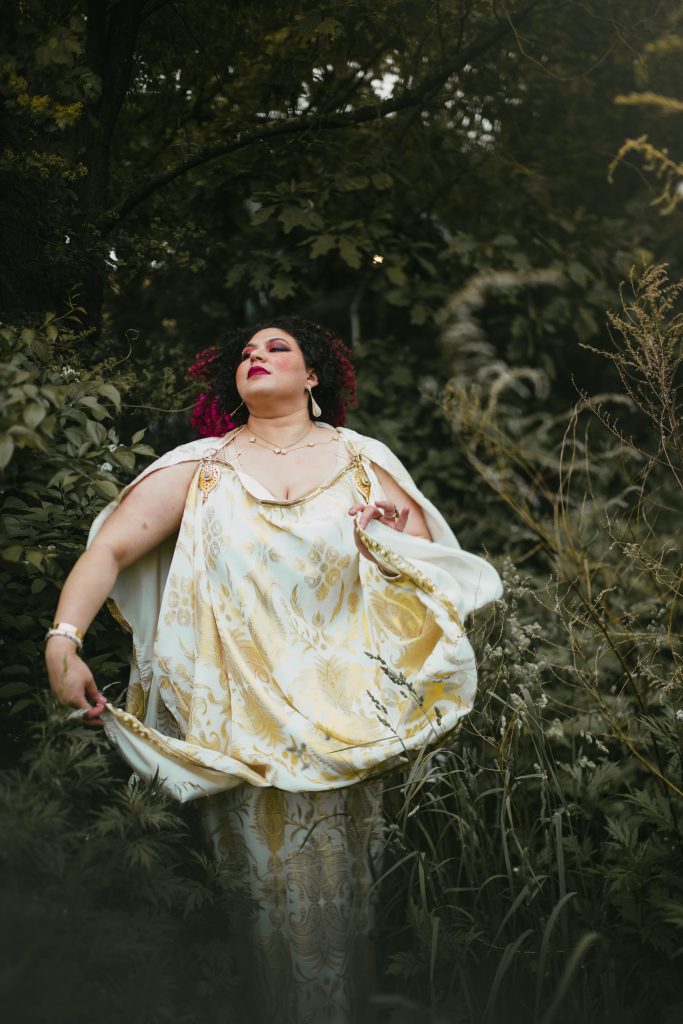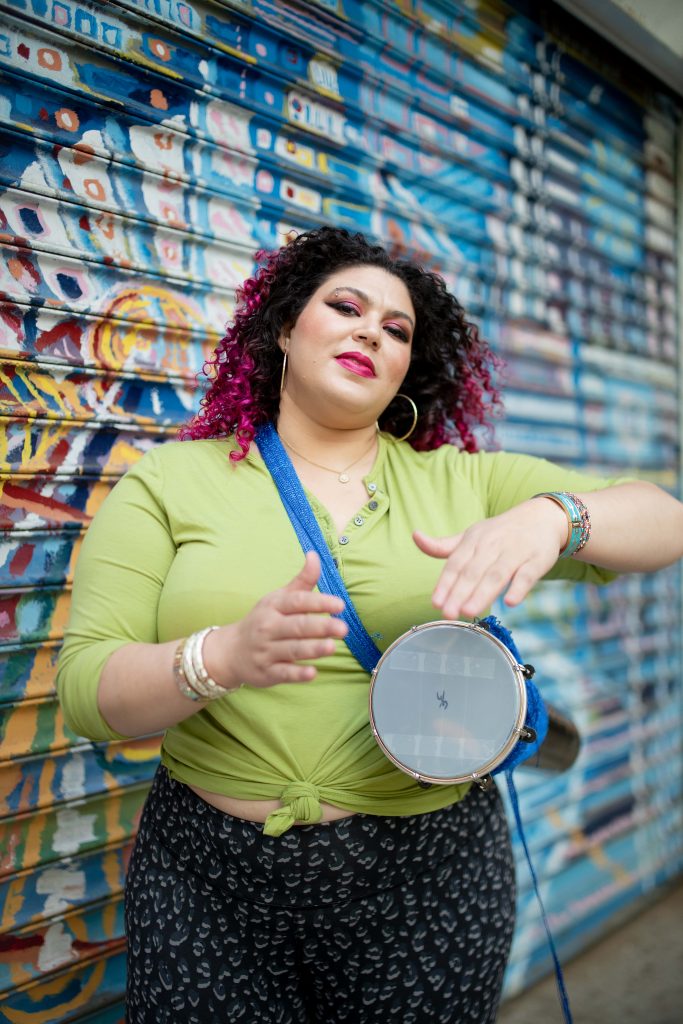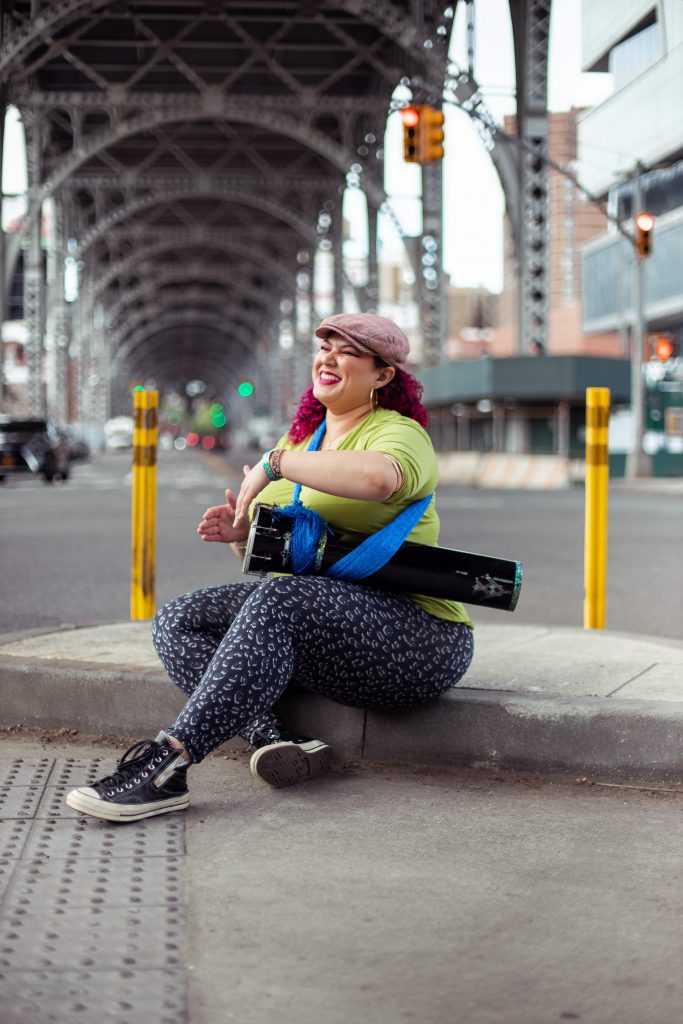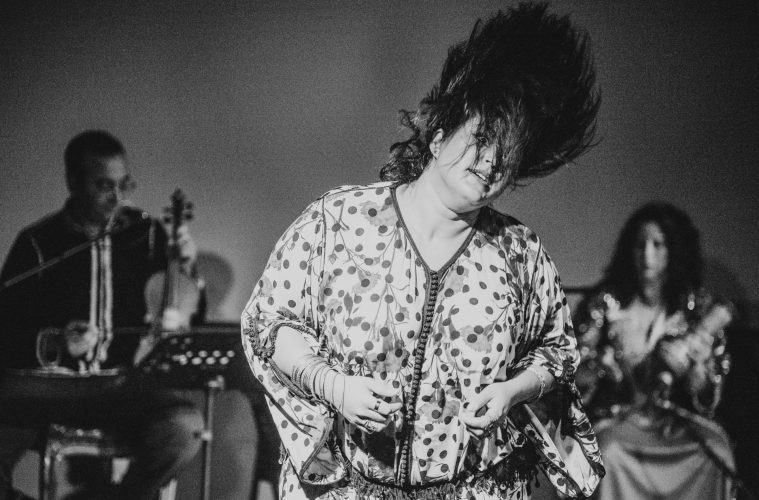Interview by Ayyur
Featured image photographed by: Robbie Sweeny
This article is part of the “Ya Leil Ya Eyein” issue
Warda is an up-and-coming New York-based artist passionate about dance and educating her students on Algerian and Moroccan traditional dance forms. A child of Algerian diaspora, Warda has been traveling North Africa to meet, study, learn and share her passion for its dances and cultures, and to advocate for a better representation and preservation of these traditions. She has shared these aims through workshops at community spaces and larger institutions including Cornell University, King’s College-London, and the University of Ottowa, and her dance journey has led her to work with notorious groups including Bnat al Houariyat at a 2021 Visa for Music concert.
I caught up with Warda to speak with her about past adventures and ones to come. In the below conversation, Warda shares more about her craft and deep understanding of North African rai and Chaabi dances’ origins. Embracing diverse music practices, she discusses how connections can form through featuring artists and musicians from around the world, as illustrated in her North African rhythms meets Mexican son jaracho song, “Roubla Mexicana.” Through her dance practice and the workshops she leads, Warda aims to decolonize eurocentric and orientalist perceptions of dance by giving value to North African dance forms and culture, and to push back against patriarchy and hshouma (shame) associated with it.
I believe that memory plays such a key role in how we reflect and perceive the world. What are some of your oldest memories of dance?
I want to give you one memory. I was born in Brooklyn, New York, in a North African family. I went to Algeria for the first time when I was 12, and let’s just say that Algerian dance, and specifically rai, was the first “movement vocabulary” that I ever downloaded in my body. I didn’t know anything else before that, so when you see me dancing anything else (salsa or reggae or whatever) it always looks like I’m dancing rai or chaabi or something. It’s my first body culture, the first way my body was educated in movement.
When I came back from Algeria for the first time at 12 years old, I had stacks of CDs. I had gone to a store in the capital, Algiers, and bought about 10 of them for not even one dollar. Back at my family’s apartment in Brooklyn, I would listen with headphones secretly on the communal computer — we didn’t have a laptop at the time. We had one computer for everybody. I would listen to rai but my parents didn’t really think it was appropriate to listen to it at home; they saw my music as “trashy,” for lack of a better word, or music that’s not “respectable.” I grew up listening to rai music which is already a marginal experience.
Later, I started to have kind of parties in my house after school but my parents were very very strict; the parties were till 4 in the afternoon. I used to introduce rai music to my friends saying, “Yo, I got to put you on this shit, rai music yo is so fly.” I got my Lebanese friends, my Albanian friends, my white friends, and introduced to them this world of underground music.
The way I envision dance is that I put it in the context of music. When I began dancing to rai, I didn’t understand the depth of rai’s lyrics but I felt rebellious. I knew that it was like the blues, and I feel connected to that marginal experience.

Photograph by Tamara Hijazi
What other feelings did you feel while listening to music in this very secretive way and sharing it with your friends during these gatherings?
I felt groovy. I felt heavy on my feet and on my knees. With rai, you move slowly left to right, transferring your weight slowly from one side to the other. It almost felt like a poetic meditation, but at the same time, I felt like a badass because I wasn’t allowed to listen to it. For me, it was a chance to be rebellious and made me realize that you have to hide part of your life in order to do what you want in a North African household, you have to hide a part of your life. Rai music introduced me not to a nationalist or patriarchal idea of being an Algerian person, but to accept who I am as a marginal person. Music and dance provide the space to be ourselves at the margins.
Going back and forth from Algeria, you said you found liberty there that you were not able to find in the US, which might be the opposite of what people expect. Why do you think this is the case, especially for dance? How did you find that space?
Especially with dance, yes. I tried to recreate something I was introduced to in Algeria in New York: the ambiance of an only women-private gathering in a house or private space in which people really let go and dance. People can converse, have dance competitions, and create an aura of joy. It almost feels like a never-ending ecstasy of fun: everything goes, you can wear whatever you want, you can say whatever you want. And you can dance however you want without thinking about who’s looking at you or what people are going to think about you. I’m not saying it’s perfect – there’s also jealousy, al ghira – but for the most part, I missed that community building that happens in a living room. I really missed it.
The living room has become a source of inspiration for me and my whole life. I felt free, freer than anywhere I could imagine at that point. At that age, it was the only place where I felt I could be myself. I didn’t really have those spaces as much in New York, which is why I said that back home I felt something was inside of me, like an energy that could move more freely in those private spaces.
We have to spend our lives trying not to piss of and not to be shameful in front of men.
You said you discovered music through dance. Did you think you would ever “study” the dance when you first fell in love with it?
I didn’t go out to fall in love with it – it kind of found me. There is no way of formally studying popular music; the only way you study it is on your own through experience. You listen to music all day and all night and surround yourself with “elders.” That’s what I did whenever I went to Algeria – I was always around my elders, my aunties, my cousins. And I was always listening to music. Until this day, I wake up in the morning and the first thing I do is put on music, even if I am still in bed.
You listen to music when you’re younger but now that I’m older, I listen even more closely to the lyrics. I realized that if you want to understand North African music and study it deeply, you have to understand the stories that are being told secretly in the music. Again, it’s in the music that you find a space for liberation that is told through indirect words and poetry, especially for rai artists who share a lot of identities and perspectives and stories. It gets at the separation between the private and the public, between the artist and the audience. If you convey a sense of mystery to your music you’re leaving things for interpretation. That’s the kind of philosophy that I go by in life, in my dance, my sexuality, and my performance; I leave it up to interpretation.
Getting back on your creative process, at some point, you decided to become an instructor. When did you tell yourself, “I want to teach and transmit what I have learned,” and why?
I’m still trying to figure out why I did that at that point, but it’s kind of an accident. Have you ever had a moment in your life when you do something but don’t know why you did it? That happens to me every two years: I do something big and impulsive. No justification, no explanation, no nothing.
What I can say is that, about seven years ago, I was working at a nonprofit where I was a young girl in high school. I decided to include some dance in the program and I noticed they were saying, “we want to dance, we want to dance.” I made a whole social justice curriculum and they didn’t give a shit about it. They were like “oh, can you put on some music?” So, we never actually ended up having the classes; instead, we put on the music (usually more Egyptian or Yemeni or Debka) and they did whatever they wanted. One day, I asked, “do you want to learn a little bit more about my music, rai music, and Moroccan music?” They said yes and I started teaching them about our music informally and how we dance. From there, I guess I was kind of “inspired by death” moment and saw other opportunities come up.
I started to teach North African dance because I felt the world called me to it. I know it’s cliche, but I felt I had to do it and that there was an opportunity and people who wanted to learn. My first workshop was public and free, and I had people from all over New York coming. We had people of color, some African folks, some trans and non-binary people, queer men, queer women … everybody just came to this one place. I was naive at that point. I didn’t realize that I could do it as a career, but that’s what it turned into.

Photograph by Tamara Hijazi
You said that you were in female-centered circles in Algeria. In North Africa, there’s a history of trans men being part of a community of women when dancing, but did you expect this level of diversity in your workshops?
Those women-only spaces are also the only spaces where people with different gender and sexual identities can actually come. That’s the only space that, for instance, a trans woman or queer man can come before and perform. It’s one of the safer places – I wouldn’t say entirely safe, but safer.
When it comes to body image and dance, it seems to be about reclaiming your body. How has dance and music helped you navigate body issues?
To be honest, I’m still navigating. Let’s get philosophical. I really think the number one fight against dancing as North African people is hshouma. That’s the number one, this cultural and social norm. I swear to God, I have seen people who have been dancing their entire life, and as soon as a man walks into the room or they see a man looking at them, their whole body and posture changes immediately. We still have this cis-heteronormative hshouma. We have to spend our lives trying not to piss off and not be shameful in front of men.
Hshouma is a patriarchal concept that I’m always battling with. So even when I’m up on stage, I’m still internally fighting that saying “no, I should not be ashamed,” or, “this is not a shame.” It’s been ingrained in our bodies so deeply; the tumor of hshouma informs how you dress, speak, walk or and embody your identity, sexuality, expression. It informs everything, even your punishment. You have to live with it all the time. But hshouma operates on a spectrum; how you feel it depends on the situation or what’s at stake. Though you are teaching people to learn this, you’re also having a battle internally, which is normal, against the show.
You are teaching people while fighting this internal battle. How can one approach other issues like cultural appropriation and deal with it, particularly in domains like dance?
We have to present our culture back with no gimmicks. We often feel obligated to act like clowns or self-Orientalize ourselves, especially for Western audiences and around white people, trying to fit into this caricature/fantasy person. Luckily, in New York, we don’t have those kinds of people. New Yorkers are made of immigrants, people of color, those who also come from cultures that are stigmatized and with fantasy tropes and stereotypes. So luckily, the people that I teach in New York are also coming from the same type of struggles.
What I try to do in my class is to always have an element of lecture, as well. It’s not only a movement class. I teach about how rai in Algeria has a very also stigmatized position. People love rai and often think of it as just popular. but I’m honest and open about the real sociopolitical context of that music and the dance I use and teach. I don’t go to the class and say, “Don’t shake your ass because it’s shameful.” I say, “this is how I dance”… “this is how I choose to dance”… “you’re learning to dance like me.” I explain that I’m trying to fight against the stigmatization and shame of dancing to this music and present the music’s position in society. I also give a holistic critique of that music and dance, and to show the evolution of forms of dance so people really understand the history. It’s important to teach them what it means, where it comes from and the obstacles it confronts, how it’s interpreted by people and society. I’m honest about the obstacles artists face when making art.
I can help but notice that your workshops had a lot of people joining them. You don’t have a majority of white people and I don’t think that’s the audience that you’re aiming for…
But they come, they do. They’re like robots … they go everywhere.

Photograph by Tamara Hijazi
You attract a number of people to your workshops, many of whom are from minority backgrounds. How do you create a space that allows participants to be impacted? What are some of those outcomes for individuals?
I create the type of dance spaces following a logic of equity and not equality. I don’t believe that we should treat everybody exactly the same, and we should give them everything exactly the same. I feel that everybody deals with a different combination of oppressions and privileges, and we should strive for things to be just not equal.
I see the space I create as a society in which the people who need the most attention get it. The people who have the most at stake in the North African dance classes are North African marginalized people and these are the people who deserve to be here the most and have the easiest access to my classes.
The main purpose of my work is to reconnect diaspora people back to the homeland, not to make white people happy. It’s not to appease somebody’s fantasy about North Africa but to get people backgrounded and reconnected to North Africa. Again, popular music like chaabi or rai is music made by marginal people, by poor people, by working-class people, and by socially exiled people who had no choice to leave, sometimes. I’m only adding an extra layer of interpretation.
Most of the time, we’re thinking about cis-heteromen when we think of marginalized artists. You know, we think about marginalized Cheb Hasni, but he wasn’t the only one there. You have Cheb Abdo or Houari Manar and other artists who are on different spectrums of gender and sexuality. They are also part of my music. But, we don’t talk about it, we don’t speak about their identities publicly, and we don’t acknowledge it.
I think there are a number of forms of marginalization, including the marginalization of poor men, and this makes more people feel comfortable coming to my class. And, of course, no gimmicks. I don’t make a caricature of myself or my music. I don’t make a caricature of my dance. I come how I am with the fusion of personality that I have because I’m also a New Yorker. I am authentically myself so other people can be inspired by that, as well.
You defined your space as a society. How do you think dance can help marginalized and queer people shape spaces like this?
Yes. I love my work. My work is also battling the neo-colonialism that we live through microaggressions, micro violence, and hshouma. My work gives a big middle finger to all of these things, especially when it comes to cultural appropriation. The real violence around cultural appropriation is that the aesthetic image of our culture ends up changing when colonizers appropriate our culture.
Let’s just talk about dance: it changes the actual movement vocabulary of that dance. The real violence there is that that becomes the norm, now, because everything that’s neocolonial is normalized. When you have new people in the diaspora who want to learn about their movement vocabulary from Algeria, Morocco, Tunisia, they are miseducated because they’re learning some neo-colonial version and the culturally appropriated version.
My goal is to put a stop to that train. I feel that my classes push people to be proud of and preserve their cultures. I push them to be agents of their culture, to speak about it, to write and do research about it, and to dance their own dances.

